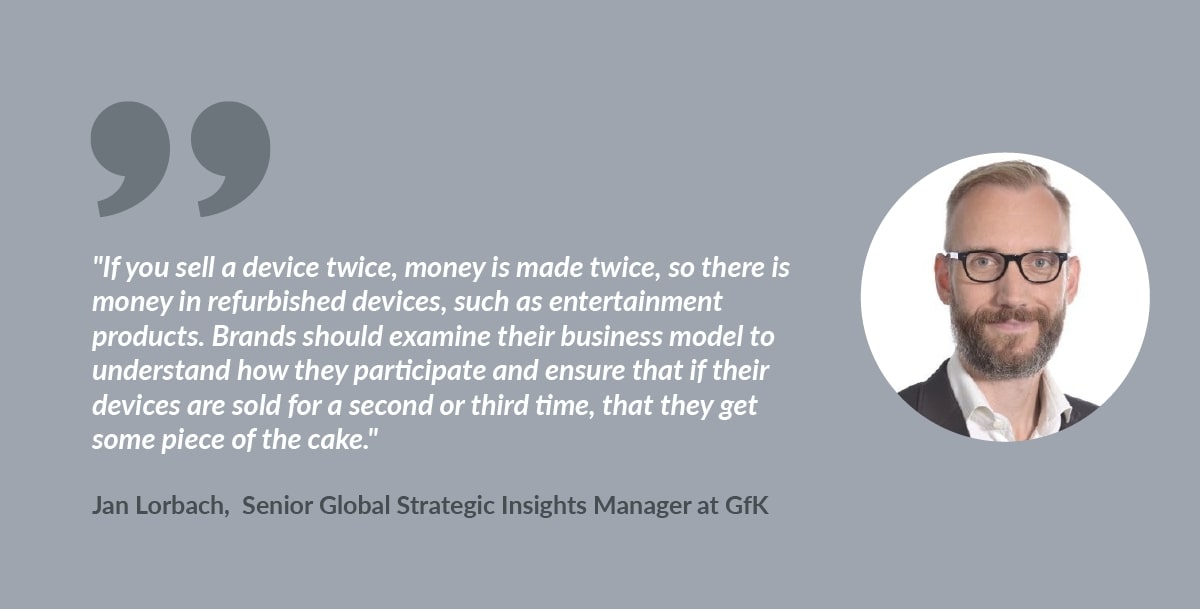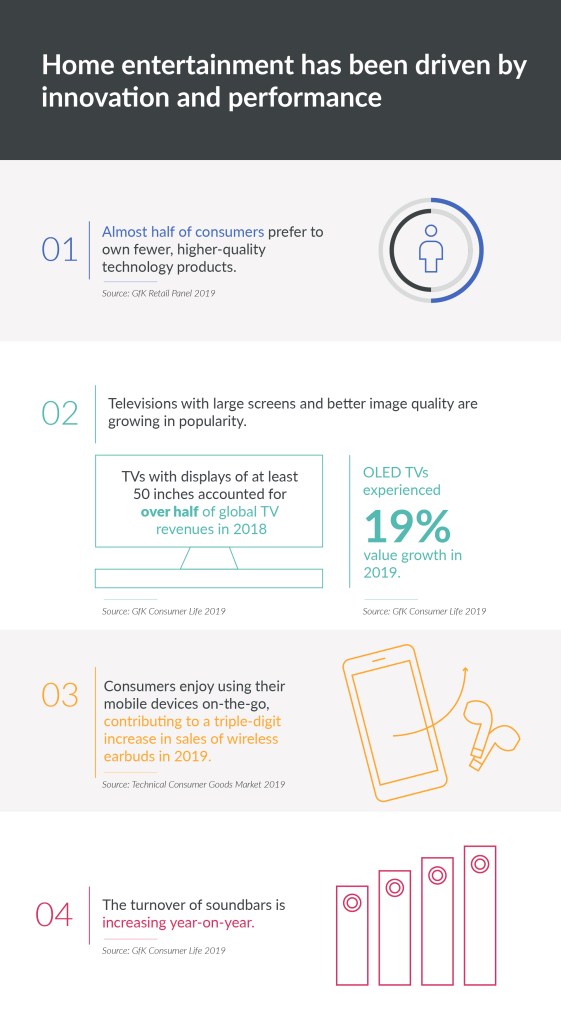The increased adoption of smart and voice-activated devices, coupled with fast broadband, is directing home entertainment trends, as consumers increasingly demand higher-quality products, greater convenience, and richer experiences.
The pandemic has accelerated these home entertainment trends. With more hours spent at home, people are looking for ways to improve their home and leisure time, often investing in new entertainment products much sooner than in previous years.
At the same time, as the pandemic pushed consumers to use more technology and durable (T&D) products, it has bolstered consumer confidence in technology. And this is triggering a change in how humans and machines interact.
Home entertainment trends: Looking back at the past 5 years
Innovation, premiumization, and performance have dominated home entertainment trends in recent years, as consumers increasingly favor having fewer, higher-quality entertainment products. GfK data from 2019 shows almost half preferred to own fewer but better technological devices.
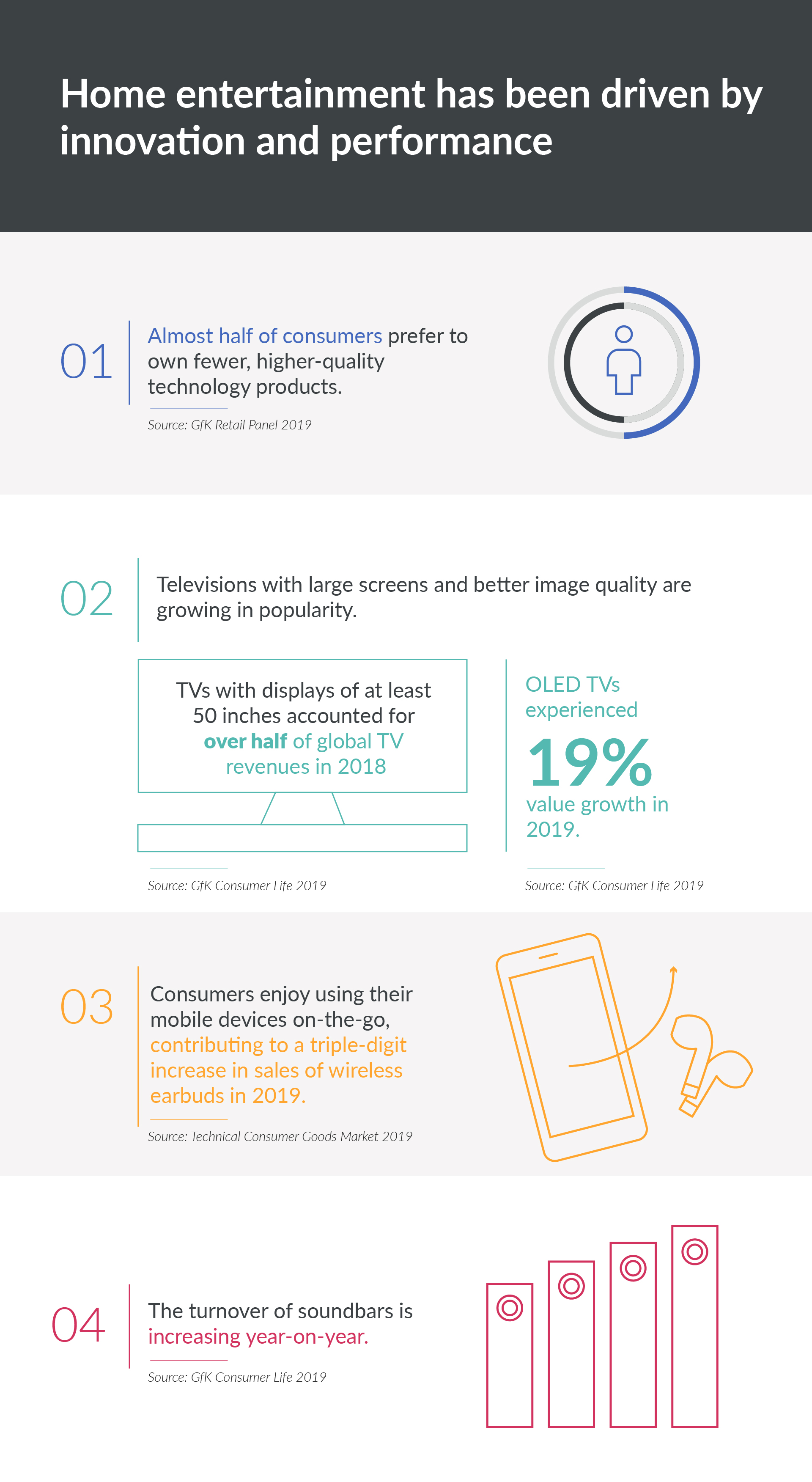
Pre-pandemic, we were in innovation cycles. The focus was on smart and premium features built-in to technology, including larger screens, online apps, connectivity, and enhanced displays.
Televisions with screen sizes of at least 50 inches accounted for more than half of global TV revenues in 2018. And smartphones with a display of at least 6 inches reached 70% in unit terms in 2019, up from 24% a year earlier. In fact, according to GfK’s latest Telecom Trend Report, screen quality is among the top three most important features that consumers consider when buying a new smartphone.
Listening to music, watching videos or playing games on the go has long been an important part of consumer interaction with their mobile device, contributing to strong growth in wireless earbuds that allow for privacy, more mobility, comfort, and style.
GfK data on trending entertainment products shows true wireless earbuds achieved a triple-digit increase in 2019, and nearly every second headset sold was wireless. That’s twice as high as their share in 2018. High fidelity has also been growing in importance, with the turnover of soundbars increasing year on year.
At the same time, cloud storage is becoming mainstream as it has given people greater convenience and flexibility.
Users can store and access data on the go, via the internet and fast connections, without having to tap into their own computer’s hard drive.
Advancements in technology have had a domino effect
Consumer demand for speed, efficiency, and convenience, coupled with greater emphasis on quality, has prompted brands to innovate with newer technologies and content formats. Everything from voice recognition and 5G-enabled devices to augmented and virtual reality is enabled by cloud computing, faster internet speeds, and more recently, the launch of 5G.
Increasingly, devices have the ability to react to voice, changing the way that people control and interact with technology. Entertainment consumer goods products, for example, are now often compatible with voice assistants like Amazon Alexa or Google Home, enabling users to command multiple connected devices verbally from a single hub. Sales of voice-controlled devices saw explosive growth of almost 61% in 2020, making them one of the year’s best sellers.
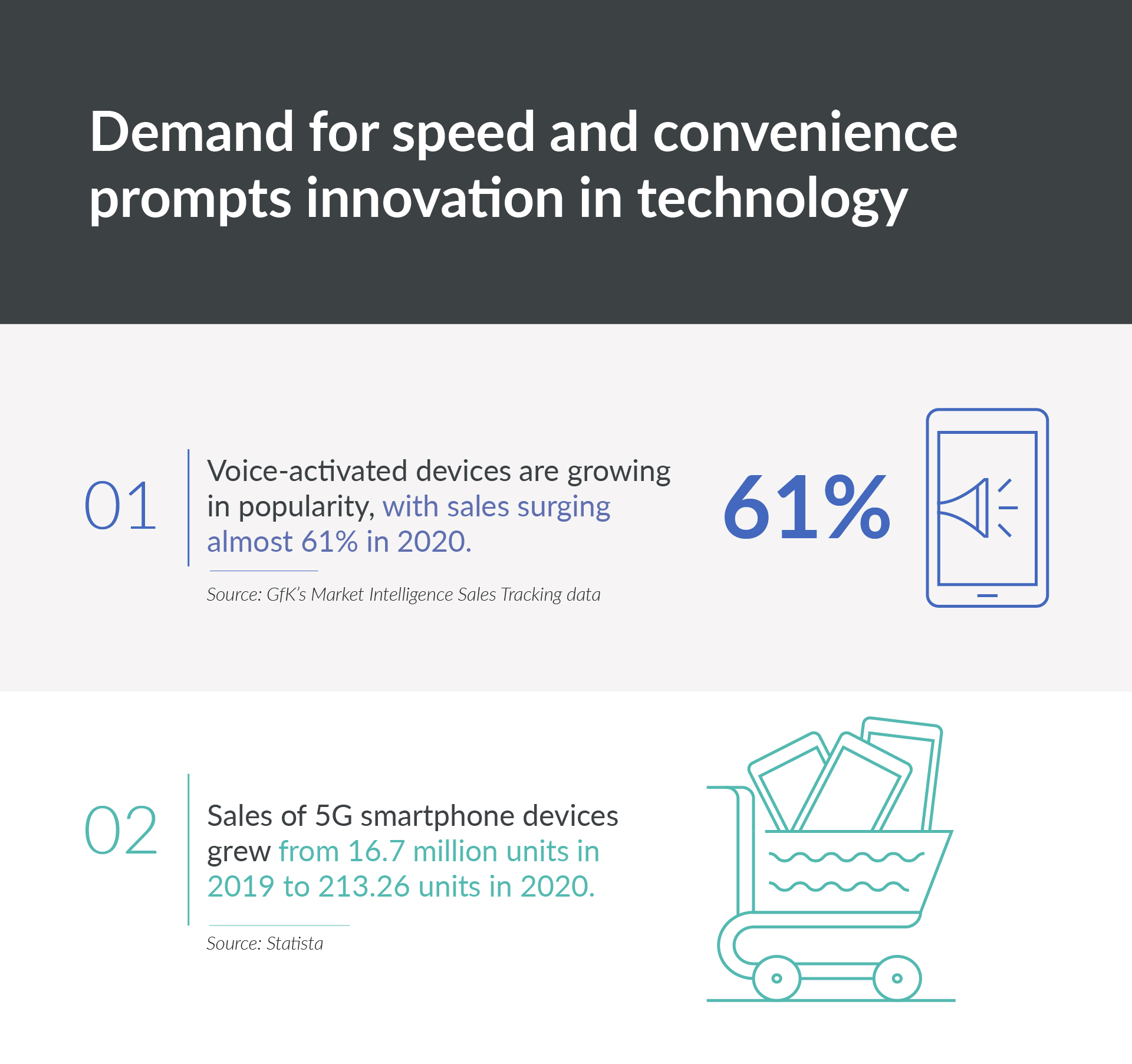
Brands are tapping into this growing demand for voice-activated products. Big Tech & Durable brands have partnered with leading smart home platforms to build virtual assistants into their hardware, such as in entertainment products like televisions. Other brands are integrating voice recognition into products, ranging from vacuum cleaners, lightbulbs, and refrigerators to security cameras.
As home entertainment trends change, and consumers purchase more products, they’ve increasingly sought enhanced experiences – particularly through the pandemic. This trend has accelerated the growth of immersive content like VR, which absorbs users in alternative worlds.
But underpinning these developments, and crucial to their increased adoption, cloud computing and fast broadband, which boost the speed and performance of connected products. Now more people can enjoy VR experiences that typically require higher bandwidths. At the same time, consumers can add more connected devices to their homes without causing issues in speed or performance.
While not yet widespread, global sales of 5G smartphone devices are growing strongly, from 16.7 million units in 2019 to 213 million units in 2020. The sales projections for 2021 are even higher, with 538 million units expected to be sold. China and developed Asia, in particular, are experiencing strong growth.
In China, according to GfK’s latest Global Telecom Trend Report, sales of 5G smartphones increased from 19% in the first quarter of 2020 to 82% in Q2 2021. In Asia, the market grew from 10% to 61% in the same period. And, while Western Europe lagged behind, it still experienced rapid adoption, growing from just 2% in the first quarter of 2020 to 38% in Q2 2021.
Staying at home due to COVID-19 drives demand and leads to faster purchases for home entertainment products
Spurred along by the pandemic, home entertainment trends are showing high demand. UK consumers, for instance, spent a record $10 billion on entertainment last year, from videos and music to gaming and digital streaming services, such as Netflix. That’s a 16.8% rise from the previous year.
Excluding North America, sales of televisions reached $33 billion in the first half of 2021, which is 18% higher than the same period in 2020. Sales of gaming keyboards experienced 34% year-on-year growth and gaming mouse devices, 26% growth. And sales of tech and durables overall grew as much as 22.7%, reaching $504 billion in July this year, according to GfK’s latest Talking Tech report.
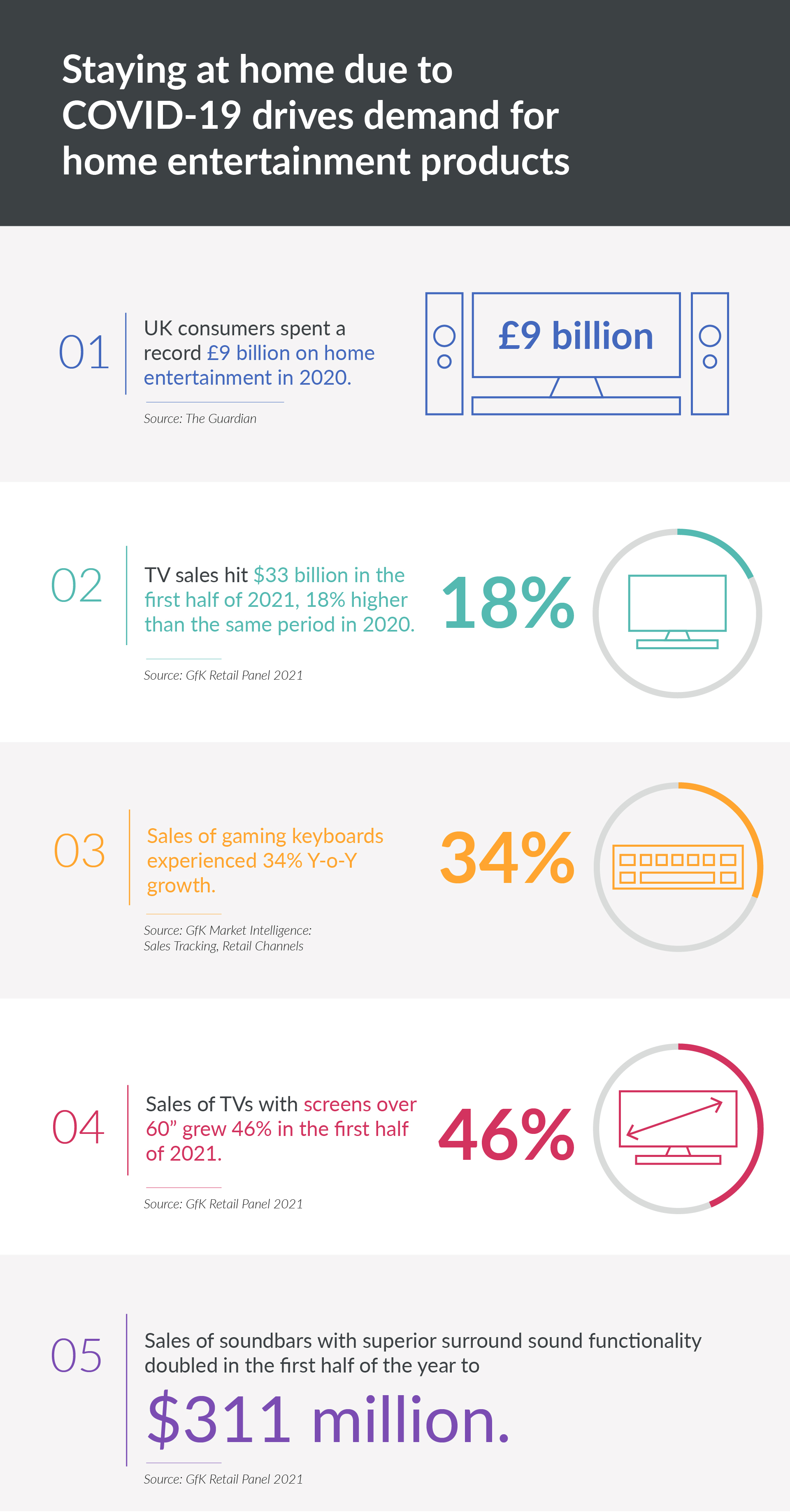
Behind this growth in home entertainment trends, there is an increasing appetite for even larger screens and more premium features. Sales of devices with screens larger than 60 inches grew as much as 46% in the first half of 2021, while sales of regular TVs remained flat. As more people are staying at home, they are using their appliances more often, so they demand better quality. In addition, 29% of TV buyers upgraded an existing working product in Q2 2021 compared to 21% in Q2 2020. Upgrades are on the rise while replacing faulty products has declined from 45% to 37% over the same period.
At the same time, global sales of high fidelity soundbars with Dolby Atmos/DTS:X functionality, offering a more cinematic experience through superior surround-sound more than doubled to $311 million in the first half of 2021, compared to the same period a year earlier. In contrast, devices without this functionality grew by just 7%.
With more time on their hands to experiment with new technology products, the changing home entertainment trend is seeing people buy products sooner than they might otherwise have done.
Customers are making smart choices
Spending more time at home through the pandemic encouraged consumers to look for products that made their lifestyle healthier, household chores easier, and downtime more gratifying. These home product trends triggered a rise in the uptake of smart devices, from kitchen appliances, fitness apps and wearables, to smart speakers and televisions.
As the penetration of high-quality smart televisions grows, so too does the desire for richer experiences delivered through immersive content such as VR. No longer confined to gaming, the VR market is growing rapidly, with the industry forecast to more than double from below $5 billion in 2021 to over $12 billion by 2024.
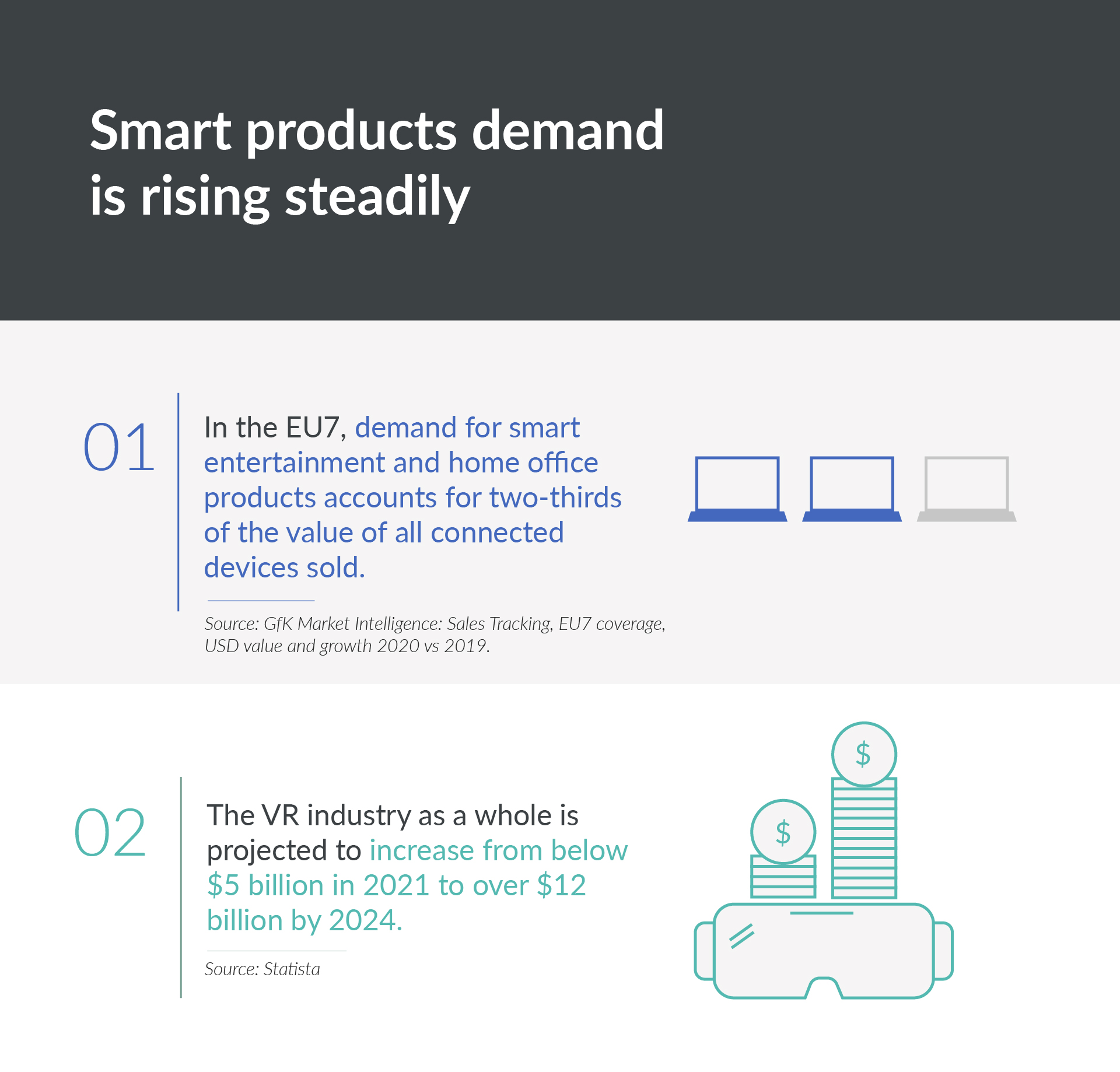
What’s next in home entertainment products?
Sustainability is emerging as a top priority for consumers, as the negative impacts of globalization on people and the environment, such as carbon emissions and plastics pollution, were felt more keenly through the pandemic. In fact, as many as 35% of consumers cite environmental pollution as their most pressing concern, above the pandemic or paying their bills, according to GfK’s latest Talking Tech report: Balancing sustainability with performance.
Historically, the focus has been on energy consumption and packaging, but now consumers are increasingly paying attention to the full lifecycle of their devices and questioning whether they really need to buy new products.
While the topic of sustainability started pre-pandemic, it’s now accelerating and getting more attention. Consumer demand, as well as financial incentives, are encouraging brands in the industry to refurbish their products and have created a market for specialized retailers to sell refurbished technical and consumer goods.
Looking five to seven years ahead, it’s likely that modular systems that enable people to replace specific components, rather than entire products, could gain ground. Taking a smartphone as an example, instead of replacing it every two years, you simply exchange the camera or the battery. Or imagine TVs where you can just switch out the speakers or even increase screen size with additional panels.
The pandemic has accelerated consumer trust and confidence in technology, encouraging people to invest in smarter, higher-quality products. For brands, this means a shift towards premiumization and ensuring that products are compatible with popular smart home hubs.
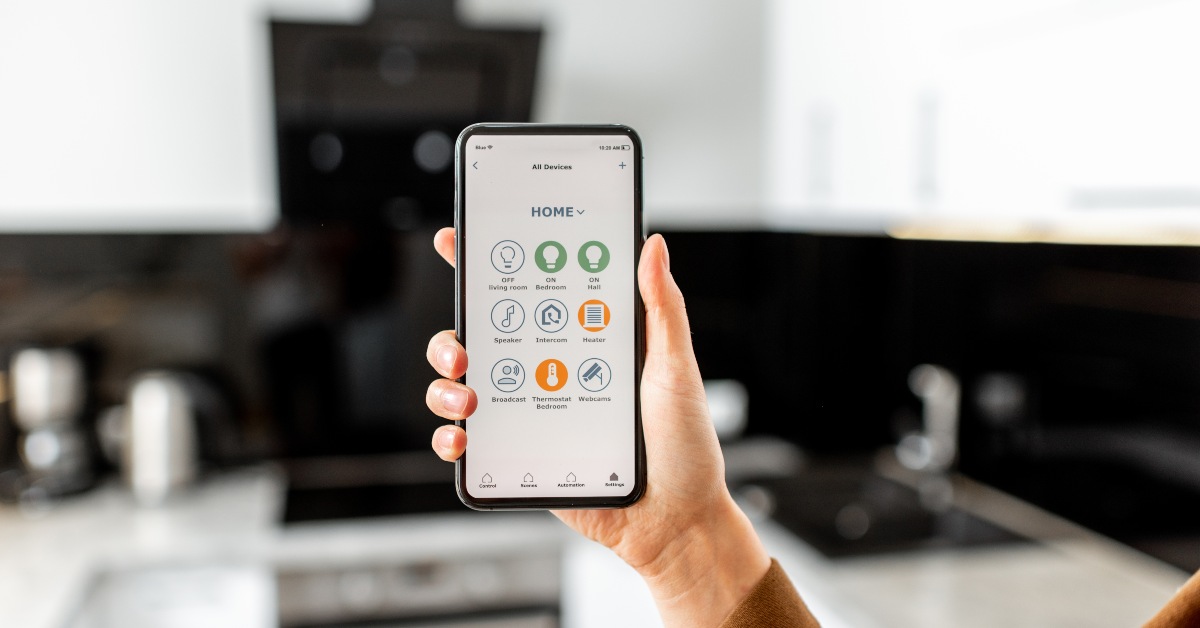
And as people set their sights on top-notch products, there is also a shift in mindset towards making devices more environmentally friendly. GfK’s latest TalkingTech report, Balancing sustainability with performance found that consumers plan to make a more conscious effort to buy from environmentally friendly brands in 2022. Many expect to look for information on the impact of brands themselves. In fact, as many as 77% of global consumers say it’s important that companies take environmentally responsible actions, yet only 19% can name an eco-friendly brand.
Modular systems may still be a way off, but the repair and refurbish trend is already here. While the innovation isn’t there yet with modular systems, it is a future home entertainment trend. There is an opportunity for manufacturers to increase the repairability of devices to meet market demand as consumers increasingly want to hold on to devices to reduce waste. We are also seeing the start of a market for specialized retailers selling refurbished devices. For brands, this is one of the home product trends to watch. As more people start to question whether they really need to invest in new products, it’s worth getting ahead by considering where and how you can make your products more sustainable. For example, through packaging, refurbished products, or even an update to communications to improve sustainability credentials.
Want to learn more about your consumers?
